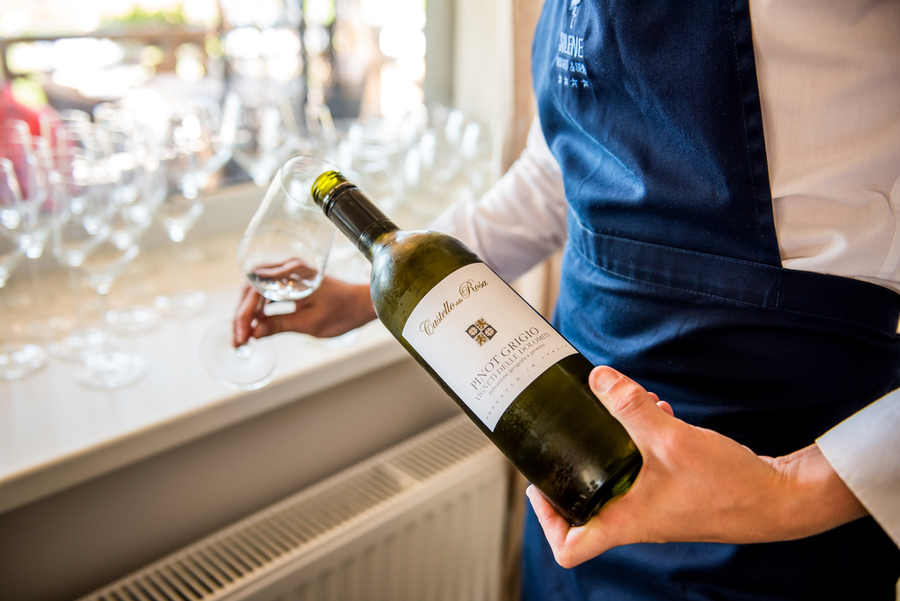
Pinot Grigio is a white wine grape that mutated from Pinot Noir. White wine enthusiasts sometimes overlook it in favor of Chardonnay and Pinot Blanc. Still, we would love to introduce you to this versatile white wine.
Pinot Grigio, the Italian name for the French Pinot Gris, is a versatile white wine with three variations—sweet and fruity, dry and mineral-like, and dry and sweet.
Pinot Grigio is known for its refreshing acidic taste with notes of citrus and salinity. The sweet and fruity version (Pinot Gris) comes from Alsace in France, while the other versions hail from Italy.
How do you drink Pinot Grigio?
Pinot Grigio is best served chilled in a white wine glass. As with all light white wines, food pairings tend to be light meals, fish, and white meat.
We’ll look at its origins in France and its spread to the rest of the Old World and New World wine regions before we unpack the three different versions of Pinot Grigio (and Pinot Gris). So, let’s dive in!
Pinot Grigio’s Origins

Pinot Grigio grapes share genetic fingerprints with Pinot Blanc and Pinot Noir. They are mutations of the red wine grape Pinot Noir.
Instead of green grapes, it is a reddish or even gray-blue grape used to make white wine. Its origins lie in Burgundy. Pinot Grigio, also known as Pinot Gris in France, translates to “gray Pinot”.
Although born or mutated in Burgundy, where most wine grapes originated, it found its way to Switzerland in the fourteenth century, where the Emperor counted it among his favorites.
The real story of Pinot Grigio began when the grapes crossed the border into northern Italy. The vines produced Pinot Grigio wine to great success in Lombardy, the Veneto, Friuli, and Trentino-Alto Adige.
Pinot Grigio has also traveled to other Old World wine regions such as Germany, Austria, Hungary, and Croatia.
It has also reached the New World regions, including Canada, South Africa, Australia, and even the United States, such as Oregon and California.
Pinot Grigio’s Taste & Food Pairings

Pinot Grigio/Pinot Gris is a sensitive grape that reacts to its terroir, influencing the wine’s taste. Taste can range from sweet and fruity to dry and mineral-like to fruity and dry. So, let’s unpack each one individually below.
Sweet and Fruity—Alsace Pinot Gris
Alsace in France produces the famous Pinot Gris wine and is one of the only two regions. You can expect to taste flavors, including honeycomb, lemon candy, and sweet apples.
There is much to discover about this unique wine when you follow this link and this one too. Winemakers can use two techniques: late harvest grapes and Noble rot.
Late-harvest grapes usually resemble raisins because they’ve been left on the vines to become almost dried out. This will intensify their flavor and sugar levels but yield slightly less juice to make wine. Typically, this will be a dessert wine due to its intense sweetness.
When a vineyard is attacked by mold, most winemakers will have a nervous breakdown and give up all hope. However, a specific type of mold is welcome in the vineyard—‘noble rot’ or scientifically known as Botrytis cinerea (follow the link for a deep academic dive but not the boring kind. I promise).
Noble rot allows the grapes to maintain their sweetness while they become dehydrated—less juice yields a lot more sugar. The flavor is also enhanced, and flavors such as ginger and beeswax are reported along with honey.
A special aromatic compound called phenylacetaldehyde is present and commonly also found in milk chocolate and buckwheat.
Food Pairings: this is a dessert wine for sipping in small quantities after a satisfying meal.
Dry and Mineral-Like—Italian Style Pinot Grigio
When Pinot Grigio is grown in steep Alpine valleys in the Trentino-Alto Adige region, the grapes maintain their acidity. You may notice a bitter almond note and acidity.
Food Pairings:
- Good options include seafood such as mussels, scallops, hake, and cod. The opportunities are almost endless, but they also include sushi and shellfish.
- Cheeses you can try are Gruyere, Grana Padano, and Muenster
- White meat such as chicken, turkey, and cured duck are good bird options; otherwise, cured pork is also a good choice.
Other food options include Fettuccine Alfredo, mushroom dishes, French fries, and slightly spicy dishes. Avoid serving it with acidic dishes, which may contain tomato or citrus.
Dry and Sweet—Italian Style
A more fruit-like orientated taste is often associated with the name Pinot Gris with flavors such as white peaches, yellow apples, and lemons. It also has a richer and more oily texture (sometimes also described as a buttery or creamy taste) in the mouth.
Winemakers get a little help from the bacteria kingdom after the fermentation process through Malolactic Fermentation.
Technically it is not a fermentation process but a chemical conversion by a specific bacteria (Oenococcus oeni and some other Lactobacillus strains) that produces lactic acid (the same as found in milk) in the wine.
Winemakers love this process for white wines because it doesn’t strip all the fruitiness away as the case is with barrel aging.
Food Pairings: you can opt for the same options as the Italian-style Pinot Grigio above; take a look at this exceptionally comprehensive wine-and-food pairing chart for future reference.
Serving Temperature & Glassware

Pinot Grigio is a light white and best enjoyed between 45 and 49ºF (7–9ºC). Chill your wine for at least two hours in the fridge to ensure it reaches this optimum temperature.
Suppose your wine is too cold (below 45ºF/7ºC). In that case, all those wonderful fruity and mineral flavors will become unnoticeable, which defies the object of drinking Pinot Grigio. Pop the bottle in an ice bucket filled with ice between pours to maintain the temperature.
Serve your Pinot Grigio in white wine glasses (preferably with a stem or double-walled stemless glasses). Fill glasses between one-third or half-full to allow the wine to release all its unique aromas.
Also, remember to hold the glass by the stem to avoid your hand warming the glass.
Conclusion
You are spoiled for choice regarding Pinot Grigio and its French counterpart, Pinot Gris. Because of the grape’s versatility, there is something for everyone on the taste spectrum, from bone-dry to sweet yet slightly acidic to dessert wines. It is a refreshing wine perfectly suited to warm weather and light meals.









